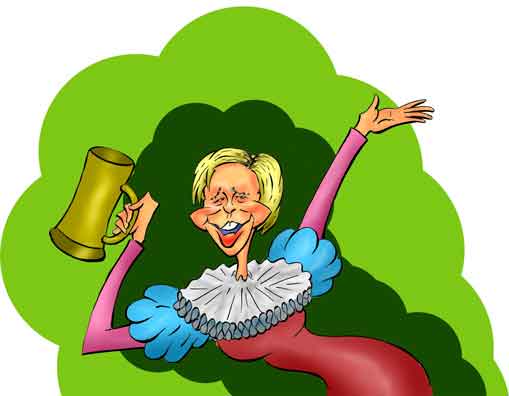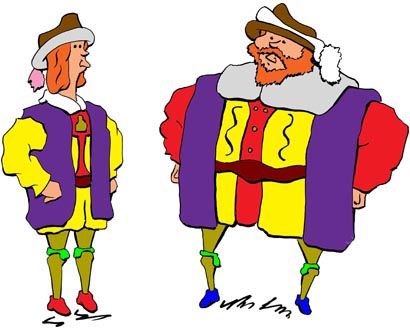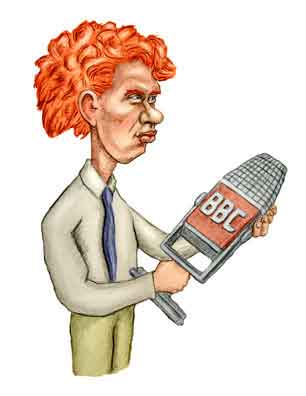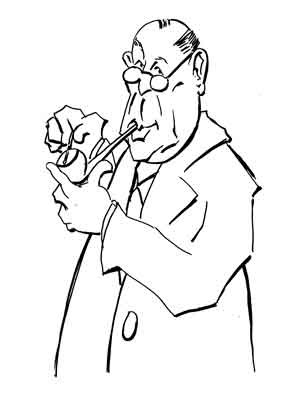Lucy Worsley

Lucy Worsley
(Dr. Worsley, that is)
Reaching the Public
For reasons that are too obscure to dwell on, the author and illustrator of CooperToons first became acquainted with the scholarship of Dr. Lucy Worsley while he was conducting some - ah - "research" on certain lifestyles of history. Lucy, it turned out, was the presenter (to use the British patois) of a film produced by Historic Royal Palaces. Historic Royal Palaces is a charity that keeps the older palaces - specifically the Tower of London, Hampton Court Palace, Banqueting House, Kensington Palace, Kew Palace, and Hillsborough Castle - in top shape. Lucy was (and is) HRP's chief curator.
The brief film - less than six minutes - was about the history of toilets in England from William the Conqueror to the Victorian Era. Among the many facts Lucy mentioned was that there were indoor chiottes in the Tower of London and she explained why they had to be put along the back wall away from the front gate, even though they were indoors. In the Tudor era, we learned that Henry VIII had a fancy portable commode - called the "closed stool" - with a padded seat stuffed with swan's down, all the better to accommodate (no pun intended) Henry's ample (and padded) backside. His courtiers and nobles also had their moveable and private, although scarcely fancy, facilities. On the other hand, the lower echelon servants had to make do with a fixed and cozy 28-seater. This was called the "common jakes", but the room itself was dubbed the "Great House of Easement".
With George III - the big baddie to Americans - we actually have flushable devices. These were actually designed so that when not in use they simply looked like a wooden cabinet. But when needed they were opened up and could be used in a manner as we do today. But although these devices were flushable, they were not actually plumbed into a sewer system. So the servants still had to clean out the receptacle containing the King's "Great Matter" and manually haul it away for disposal.
With the Victorians, though, we finally reach the conveniences that we expect today - plumbed in so everything was swushed away of without additional human intervention. We also learn that Victorians weren't satisfied with pure white decor and that even their privy devices were decorated in the highest of fashion.
A good podcast will leave the viewer hankering for more and longer shows. Happily we find that in 2008 Lucy was featured on the full-length documentary Inside the Body of Henry VIII. This was a combined effort where she teamed up with two health professionals to give King Henry VIII a rather belated physical check-up. Not surprisingly, we learn Henry was not in good shape.
One of the best parts of the show was when Lucy did Henry's weekly grocery shopping. Henry packed away about 5000 calories a day and ate virtually no vegetables. But he avoided scurvy by sampling tasty antiscorbutics like strawberries which he really liked.
Instead, Henry ate lots of meat - game, beef, pork, lamb, rabbit, and fowl (including chicken, peacock, and swan). He also drank about 10 pints of ale a day as well as red wine spiked with sugar. Of course, there was lots of bread. It was expensive white bread, though, not whole wheat. Whole grain stuff? That was for (ptui) peasants.
When Lucy got to the checkout counter, the total cost was nearly £500. Remember this was in 2008 and ticking in exchange rates and inflation, today the bill would have been over $1000. But in Henry's day the cost would have been much more. Spices and sugar were expensive, and although the Tudor diet, even for lower classes, was meat-rich, the choicest cuts and best quality bread went to the rich. There were even "sumptuary laws" that stipulated who could eat what.
We also know Henry's diet was spiffy-upped with pepper, ginger, cloves, and cinnamon. These spices, although expensive, were not necessarily unhealthful. But Lucy pointed out that Henry's daily intake included about 20 grams of salt - about triple the recommended dosage. All in all, Henry's diet would have produced not only his vast wobbling physique, but elevated blood pressure, rapid heart rate, a fatty liver, and most likely diabetes. It's really surprising that Henry managed to live as long as he did. He actually made it to age 55.

Henry VIII
Before and After
We see then that there is a connection between Lucy and Welsh poet Dylan Thomas and writer C. S. "Jack" Lewis. And this connection is that to become scholars/celebrities none of them really had to go through the academic tedium of cranking out tons of articles in journals that no one reads. Jack, although a tutor at Oxford and later professor at Cambridge, lived before publish or perish meant you had to publish or perish. Instead he actually published little original research. His most notable contribution was the The Allegory of Love, first published in 1936. Dylan's poems like "Do Not Go Gentle Into That Good Night" are considered major achievements of 20th century literature, but Dylan was never an academic.

Dylan Thomas
Him, too.
Instead all three - Dylan, Jack, and Lucy - became well-known scholars mainly through the electronic media. Dylan achieved celebrity only after he began reading his poetry on BBC radio. And although Jack's books have been best-sellers for over half a century, they achieved their widespread popularity only after he began broadcasting on the BBC. And we see that Lucy was able to first reach the public through the very new medium of the Internet podcast and has since become one of the most popular historians and presenters on British television

Jack Lewis
And him.
Another of the early and brief podcasts was Hampton Court Palace: An Introduction. This again left the viewer wanting more and fortunately in 2015, Lucy teamed up with David Starkey, one of the most distinguished English historians in Britain's Tudor Treasure: A Night At Hampton Court.
One nice thing about Lucy's shows is she explains why things that seem stupid and crazy now were not so stupid and crazy when put into the perspective of their own time. In The First Georgians: The German Kings Who Made Britain, she explains why in 1714 England went to Germany to find a king. Although today - as depicted on the Horrible Histories - it seems ridiculous that England would want a king who spent most of his time in Germany and never learned English, Lucy shows us that shopping abroad for a monarch made sense - that is, if you want to stick with a monarchy. And all in all, the current ruling "house" has turned out not all that bad.
Americans may actually have a leg up over their English cousins in watching some of Lucy's shows. Most Americans don't know enough about English history to know that what you learn in British History's Biggest Fibs are fibs. So they don't have to unlearn what they've learned.
Of course, if you've been a big fan of real history, you've probably already learned that the story of the "Black Hole of Calcutta" was exaggerated. Not that there weren't a lot of British soldiers crammed into a small locked cell, and the majority of them died from suffocation. But the number was probably more like 60 total rather than 146, and some historians have questioned whether this notorious episode even happened. Lucy interviewed an Indian historian who points out the flaws in the traditional story. At the same time, Lucy doesn't avoid mentioning the fact that the Indian rebels did in fact murder women and children during the course of the Great Mutiny.
We can also see that a fib-at-one-time may end up being not-quite-really-a-fib at a later date. This was made clear when Lucy was talking about the War of the Roses.
Today we've had a lot of TV shows about how there has been a centuries long fib trashing Richard III. To correct this grevious fault, recent television shows have had a lot of interviews by the Richard-III-was-not-that-bad-a-guy-he-was-just-maligned-by-those-lousy-Tudors bunch.
Why it was those schmucks like Elizabeth I and her flunky William Shakespeare who invented the story that Richard was a hunchback. That is, "rudely stamp'd", "curtail'd of this fair proportion", "cheated of feature by dissembling nature", "deformed, unfinish'd" and sent "into this breathing world, scarce half made up". Sheesh! If it wasn't for Libby and Bill we would have realized that Richard was one of the greatest and most benevolent of English monarchs.
So the "true" story today is that Richard wasn't such a bad guy. The "fib" is that he was a deformed murdering schmuck.
Well, the discovery in 2012 of Richard's burial in a parking lot showed he did suffer from scoliosis - a crooked spine. So not all of the stories from the Tudors are made-up. And if this "fib" - Richard did suffer from a deformity - is actually true, what about the other "fibs". Are they true after all?
Well, let's say the questions about Richard III have not been resolved to everyone's satisfaction. But at least Lucy was conscientious enough to interview Richard's non-fans as well as his latter-day friends. With Lucy consulting a spectrum of opinion, we get a more focused - and hopefully more accurate - picture of an English King of the Late Middle Ages. Clearly, though, one man's fib is another man's revised research conclusions.
But we certainly have to admit the traditional story about Richard III was told by his enemies who needed to justify their own claim to the English throne. But it's unlikely Richard was any more of a saint than his competitors. The Kings and Queens through the Middle Ages had no problems lopping off the heads of people who stood in their way - not even the "good" monarchs like Elizabeth I. And despite people saying you can't prove it, Richard probably did order the murder of the Princes in the Tower.
Of course, some "fibs" of history tend to be due to omission rather than commission. We find that in American history, too. We hear how George Washington declined any salary when serving as commander of the Continental Army, and only accept reimbursement for expenses. Of course, his "necessary expenses" included things like $7644 for five horses and a carriage to take him from Philadelphia to Boston (the carriage cost $1430, the horses averaged $1433 each), a harness for $201, $65 for cleaning of his headquarters, and $58 for a French cook. And in seven months - from September 1774 to March 1775 - he spent over $6000 on wine and other beverages.
And you'll read how George wanted to protect the lands of the Native Americans by keeping European settlers out of the Ohio Country. Of course, that was after he had already claimed huge tracts of western land for himself. That was also after he issued instructions during the American Revolution to General John Sullivan on how to deal with the Native Americans suspected of harboring Loyalist sympathies:
The immediate objects are the total destruction and devastation of their settlements, and the capture of as many prisoners of every age and sex as possible. It will be essential to ruin their crops now in the ground and prevent their planting more.
But you will not by any means listen to any overture of peace before the total ruinment of their settlements is effected.
First in war, evidently. But clearly not first in peace.
References
Lucy Worsley, http://www.lucyworsley.com/
Historic Royal Palaces, https://www.hrp.org.uk/
Toilets Through Time, Lucy Worsley (Presenter), Historic Royal Palaces, 2008.
Hampton Court Palace: An Introduction, Lucy Worsley (presenter), Historic Royal Palaces, 2009.
Britain's Tudor Treasure: A Night at Hampton Court", Lucy Worsley (presenter), David Starkey (presenter), BBC, 2015.
Inside the Body of Henry VIII, Lucy Worsley (Presenter), Robert Hutchinson (Presenter), Dr. Catherine Hood (Presenter), Bray Poor (Narrator), National Geographic, 2008.
The First Georgians: The German Kings Who Made Britain, Lucy Worsley (Presenter), BBC, 2014.
British History's Biggest Fibs, Lucy Worsley (Presenter), BBC, 2017.
"Bones Under Parking Lot Belonged to Richard III", John Burns", The New York Times, February 4, 2013.
"The Luxury Trades of the Silk Road: How Much Did Silks and Spices Really Cost?", John Monroe, Lecture, Royal Ontario Museum Continuing Education Symposium, University of Toronto), October 12, 1983. Reissued as "The Consumption of Spices and Their Costs in Late-Medieval and Early-Modern Europe: Luxuries or Necessities?", Center of Medieval Studies, University of Toronto.
Tudor Dining: A Guide to Food and Status in the 16th Century", Emma Mason, History Extra, BBC History, December 8, 2014.
"From George Washington to Major General John Sullivan, 31 May, 1779, Founders Online, National Archives, Washington, D. C.